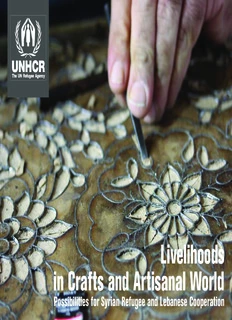
Livelihoods in Crafts and Artisanal World PDF
Preview Livelihoods in Crafts and Artisanal World
Livelihoods in Crafts and Artisanal World Possibilities for Syrian Refugee and Lebanese Cooperation The Continuity of Shared Traditions UNHCR Livelihoods : Finding global markets for traditional crafts Every day refugees cross borders from home to host countries with little to call their own but with skills and vocations intact. In Lebanon, over 1 million people who fled violence in Syria are struggling to make ends meet while putting a strain on Lebanese infrastructure and increasing competition for jobs. The UNHCR global Livelihoods Program supports self-reliance by assessing refugees’ interests, skills and productive assets and matching them with market opportunities. However, with the refugee population projected to comprise over one-third of Lebanon’s population by the end of 2014, UNHCR is also focusing on finding ways to ease tensions between the two communities. Promoting livelihood opportunities for both communities is one of these ways. The arts and crafts sector offers opportunities for skill transference and an increased job market benefitting refugees and Lebanese alike. Within Lebanon, the design, arts and crafts scene has some well-known innovators who have achieved much acclaim. Combining the renowned entrepreneurial spirit of these Lebanese entrepreneurs and their flair for design with the skills of talented men and women artisans provides a promising entry point for meaningful and mutually beneficial livelihoods programs. Many Syrians are highly skilled in traditional arts and crafts – either formally as professional artisans, or informally through, for example, the fine embroidery work done at home. Over 15% of Syrian refugees identify themselves as artisans. These traditions have been practiced for millennia and many of the designs are unique to the region. However they have little presence in the global market. UNHCR aims to increase the demand for traditional crafts from Lebanon by identifying an international market for these high quality products and providing access to global marketplaces, including online markets. UNHCR would provide or facilitate access to business skills training, including financial skills, and literacy and numeracy where needed, as well as IT know-how to best access online markets. Lebanese businesses would be able to draw on the labor force of skilled Syrian and Lebanese craftspeople to design innovative and attractive products while accessing new and wider markets. Refugees would be provided with an opportunity to use their skills and generate income to support their new lives in exile. They would become an added value to a burdened economy. These programs would support what has already been a long history of cooperation between the Lebanese and the Syrians in handicrafts. Equally important, they would foster greater social cohesion and understanding between refugees and host communities while creating economic opportunities for both. Meet Ibrahim Formerly the owner of his own business in Syria, he exported his wares to the Gulf countries as well as to a shop in Lebanon. He now has a workshop in the same shop’s basement, along with four other handicraft workers. His wife does embroidery from home, while the children attend school. Many more Syrian refugees could be supporting themselves. Primary Materials Mother of pearl sourced from the Tigris River in Syria. Restoration of an old chest, undertaken by Syrian refugee artisans. Modern Interpretations Simplified versions of the art of mother of pearl inlay. Preserving the art while creating modern, easy to reproduce versions suitable for new markets. Lebanese Entrepreneurs and Workshops This Lebanese owned workshop is the largest in Lebanon. Alongside the Lebanese artisans, they have hired several Syrian refugees who are admired for their skills. However, their own business is suffering with the loss of the tourist trade. If they had more orders, they would hire more skilled workers. The Hands of a Refugee The hands of a refugee at work, creating beautiful objects for others’ homes, even as his own has been destroyed. He carries with him his dignity and centuries worth of skills. The Process The tin inlay wire has already been inserted in the painstakingly carved outline of the pattern, flush with the wood. Now the areas that will contain the mother of pearl are being carved out.
Description: